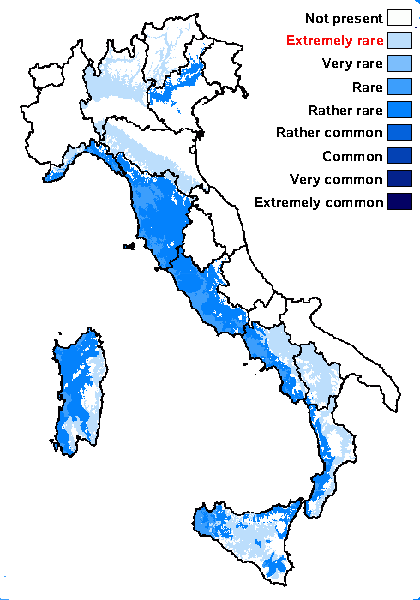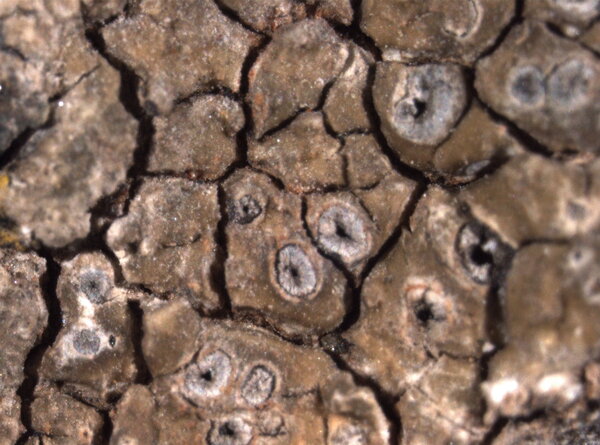Diploschistes euganeus (A. Massal.) J. Steiner
Verh. zool.-bot. Ges. Wien, 69: 96, 1919. Basionym: Limboria euganea A. Massal. - Ric. Auton. Lich. Crost.: 155, 1852.
Synonyms: Diploschistes clausus (Flot.) Zahlbr.; Urceolaria euganea (A. Massal.) Jatta; Urceolaria subsordida Nyl.
Distribution: N - Ven (Lazzarin 2000b), TAA, Lomb (De Vita & Valcuvia 2004), Emil (Fariselli & al. 2020), Lig (Valcuvia & al. 2000). C - Tosc, Laz, Sar (Rizzi & al. 2011). S - Camp (Nimis & Tretiach 2004), Bas (Nimis & Tretiach 1999), Cal (Nimis & Puntillo 2003, Puntillo 2011), Si.
Description: Thallus crustose, episubstratic, continuous to usually rimose-areolate, grey to brownish grey, smooth, dull or slightly shiny, epruinose, consisting of irregularly angular, 0.3-1.5 mm wide and 0.15-0.9 mm thick areoles. Medulla white, I-. Apothecia perithecioid, immersed to semi-immersed in the areoles, up to 1.8 mm across (in section), with a blackish but sometimes white-pruinose, at first urceolate then flat disc which is not always visible from above, being concealed by a thick, entire or usually radially sulcate proper margin; thalline margin thin, poorly visible. Proper exciple up to 90 µm thick, carbonized, 70-90 µm thick, pseudoparenchymatous; epithecium poorly differentiated, colourless to brownish; hymenium colourless, 100-140 µm high, non-amyloid; paraphyses simple, flexuose, 1-1.5 µm thick, not swollen at apex. Asci (6-)8-spored, subclavate, the wall evenly thickened, with an abrupt apical thickening and a thin internal apical beak, lacking an apical apparatus. Ascospores muriform, at first hyaline, then turning brown, broadly ellipsoid to subglobose, 16-32 x 10-20 µm, with 3-6 transverse and 1-4 longitudinal septa. Photobiont chlorococcoid. Spot tests: K-, C-, KC-, P-, UV-. Chemistry: without lichen substances. Note: a mild-temperate lichen found on basic siliceous rocks, more rarely on brick and roofing tiles, in warm-humid areas, sometimes starting the life-cycle on Ochrolechia parella; most frequent in Tyrrhenian Italy.
Growth form: Crustose
Substrata: rocks
Photobiont: green algae other than Trentepohlia
Reproductive strategy: mainly sexual
paras (occasionally) of Ochrolechia parella when young
Commonnes-rarity: (info)
Alpine belt: absent
Subalpine belt: absent
Oromediterranean belt: absent
Montane belt: absent
Submediterranean belt: extremely rare
Padanian area: absent
Humid submediterranean belt: rather rare
Humid mediterranean belt: rare
Dry mediterranean belt: absent

Predictive model
Herbarium samples


P.L. Nimis; Owner: Department of Life Sciences, University of Trieste
Herbarium: TSB (11585)
2001/11/24

Courtesy Danièle et Olivier Gonnet - Source: https://www.afl-lichenologie.fr/Photos_AFL/Photos_AFL_D/Textes_D1/Diploschistes_euganeus.htm
France, Cap corse tour d'Agnello - Corse
20/11/2012
Growth form: Crustose
Substrata: rocks
Photobiont: green algae other than Trentepohlia
Reproductive strategy: mainly sexual
paras (occasionally) of Ochrolechia parella when young
Commonnes-rarity: (info)
Alpine belt: absent
Subalpine belt: absent
Oromediterranean belt: absent
Montane belt: absent
Submediterranean belt: extremely rare
Padanian area: absent
Humid submediterranean belt: rather rare
Humid mediterranean belt: rare
Dry mediterranean belt: absent

Predictive model
| Herbarium samples |


P.L. Nimis; Owner: Department of Life Sciences, University of Trieste
Herbarium: TSB (11585)
2001/11/24

 Index Fungorum
Index Fungorum
 GBIF
GBIF










